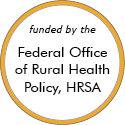Rural Project Examples: Cardiovascular disease
Evidence-Based Examples
Chronic Disease Self-Management Program
Updated/reviewed November 2025
- Need: To help people with chronic conditions learn how to manage their health.
- Intervention: A small-group 6-week workshop for individuals with chronic conditions to learn skills and strategies to manage their health.
- Results: Participants have better health and quality of life, including reduction in pain, fatigue, and depression.
Project ENABLE (Educate, Nurture, Advise, Before Life Ends)
Updated/reviewed May 2025
- Need: To enhance palliative care access to rural patients with serious illness, such as advanced cancer, heart failure, and COPD, and their family caregivers.
- Intervention: Project ENABLE consists of: 1) an initial in-person palliative care consultation with a specialty-trained provider and 2) a semi-structured series of weekly, phone-delivered, nurse-led or palliative care coach/navigator sessions designed to help patients and their caregivers enhance their problem-solving, symptom management, and coping skills.
- Results: Patients and caregivers report higher quality of life and lower rates of depression and (caregiver) burden.
StrongPeople® Program
Updated/reviewed July 2024
- Need: Few older adults, particularly women and those in rural areas, participate in healthy living interventions.
- Intervention: Health educators lead community-based healthy living classes, which include strength training, aerobic exercise, dietary skill building, and/or civic engagement, depending on the program.
- Results: StrongPeople® programs have been shown to improve weight, diet, physical activity, strength, cardiovascular health profile, physical function, pain, depression, and/or self-confidence in midlife and older adults.
Effective Examples
Health Coaches for Hypertension Control

Updated/reviewed November 2025
- Need: A cost-effective approach to help rural patients with hypertension learn to manage their condition.
- Intervention: Community volunteers trained as health coaches provided an 8-session hypertension management training program to hypertension patients older than 60, with an optional supplemental 8 sessions focused on nutrition and physical activity.
- Results: Just 16 weeks after the program, participants had improved systolic blood pressure, weight, and fasting glucose, greater knowledge of hypertension, and improved self-reported behaviors.
Kentucky Homeplace
Updated/reviewed October 2025
- Need: Rural Appalachian Kentucky residents have deficits in health resources and health status, including high levels of cancer, heart disease, hypertension, asthma, and diabetes.
- Intervention: Kentucky Homeplace was created as a community health worker initiative to provide health coaching, increased access to health screenings, and other services.
- Results: From July 2001 to June 2025, over 202,000 rural residents were served. Preventive health strategies, screenings, educational services, and referrals are all offered at no charge to clients.
Franklin Cardiovascular Health Program (FCHP)
Updated/reviewed March 2025
- Need: To develop sustainable, community-wide prevention methods for cardiovascular diseases in order to change behaviors and healthcare outcomes in rural Maine.
- Intervention: Local community groups and Franklin Memorial Hospital staff studied mortality and hospitalization rates for 40 years in this rural, low-income area of Farmington to seek intervention methods that could address cardiovascular diseases.
- Results: A decline in cardiovascular-related mortality rates and improved prevention methods for hypertension, high cholesterol, and smoking.
Community Health Worker-based Chronic Care Management Program
Updated/reviewed August 2024
- Need: Improve healthcare access and decrease chronic disease disparities in rural Appalachia.
- Intervention: A unique community health worker-based chronic care management program, created with philanthropy support.
- Results: After a decade of use in attending to population health needs, health outcomes, healthcare costs, in 2024, the medical condition-agnostic model has a 4-year track record of financial sustainability with recent scaling to include 31 rural counties in a 3-state area of Appalachia and recent implementation in urban areas.
The Health-able Communities Program

Updated/reviewed August 2024
- Need: Expand healthcare access for the more remote residents of 3 frontier counties in north central Idaho.
- Intervention: With early federal grant-funding, a consortium of healthcare providers and community agencies used a hybrid Community Health Worker model to augment traditional healthcare delivery services in order to offer a comprehensive set of health-related interventions to frontier area residents.
- Results: With additional private grant funding, success continued to build into the current model of an established and separate CHW division within the health system's population health department.
Other Project Examples
Boone County Health Center Pulmonary Rehabilitation Program
Updated/reviewed June 2022
- Need: Evidenced-based intervention to improve function and quality of life for patients with chronic obstructive pulmonary disease and other chronic lower respiratory conditions.
- Intervention: Pulmonary rehabilitation program implementation in 1989.
- Results: Compared to a national average of only about 3% of referred Medicare beneficiaries actually enrolling in pulmonary rehabilitation, 60% of the program's referred patients enroll. Averaging around 15 patients/year completing the program, a large combined cardiac and pulmonary rehabilitation maintenance population averages 8,000 visits/year.
Avita Health System Comprehensive Cardiology Program
Added April 2021
- Need: Population health approach to decreasing area deaths from cardiovascular disease.
- Intervention: A health system-level investment in level II cardiac catheterization services and the required specialized cardiology workforce.
- Results: Since August 2018, the Avita Health System in north central Ohio has provided local cardiovascular services that have decreased hospital transfers, increased care coordination, and provided education and prevention activities that, with time, will impact population health cardiovascular outcomes.
For examples from other sources, see:
